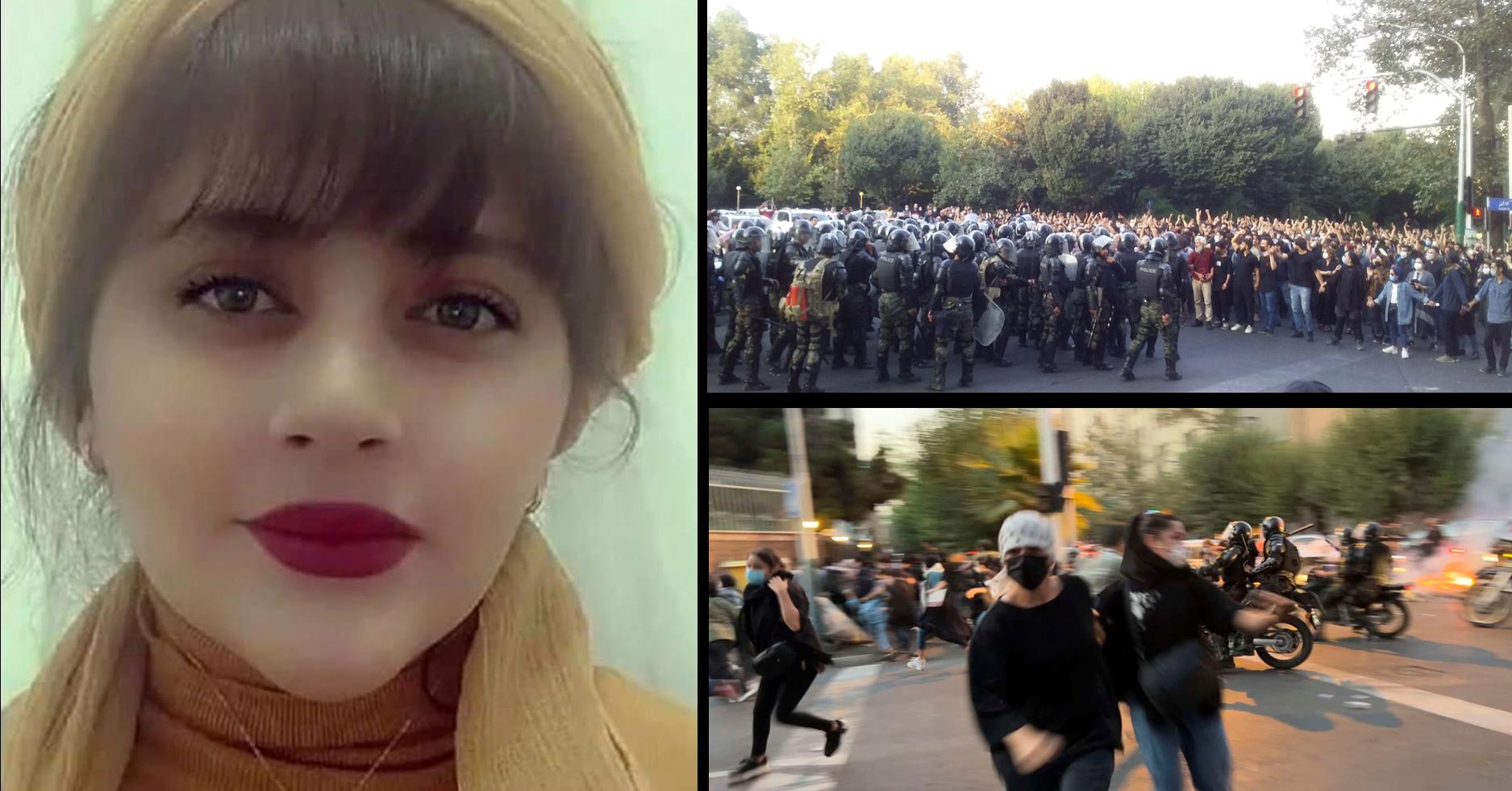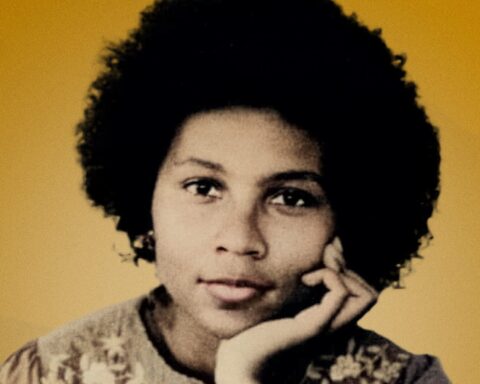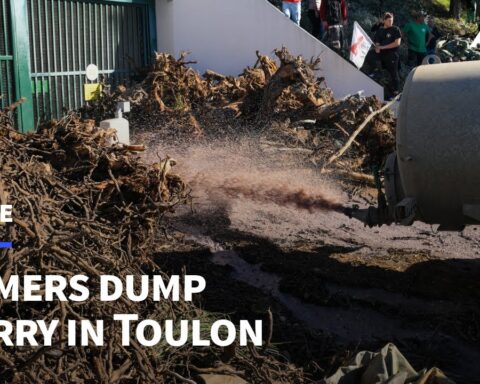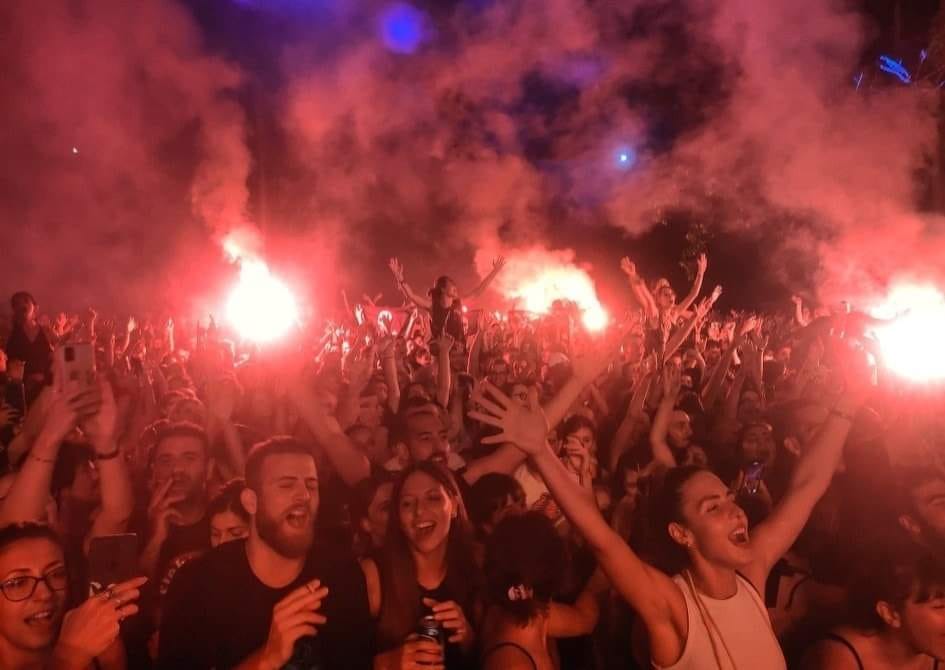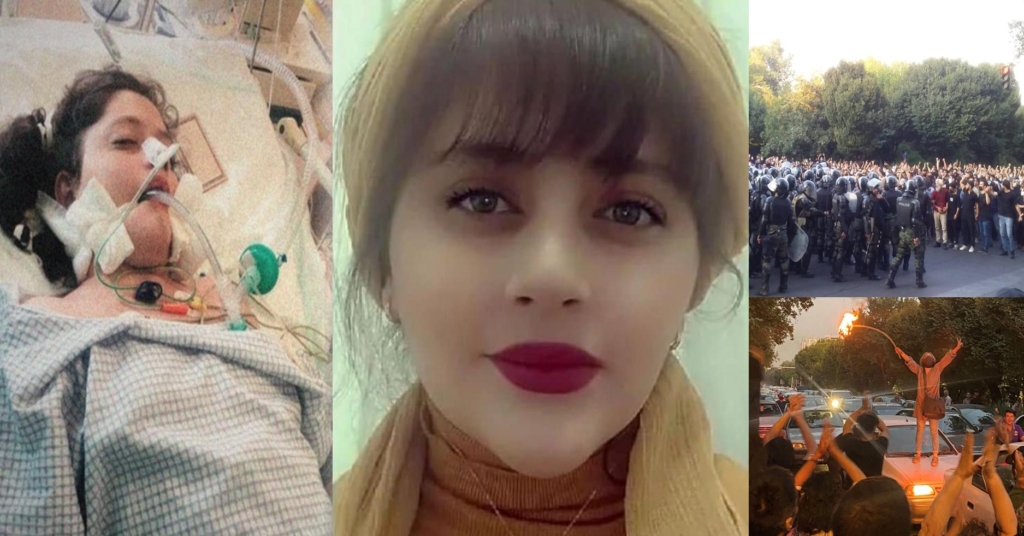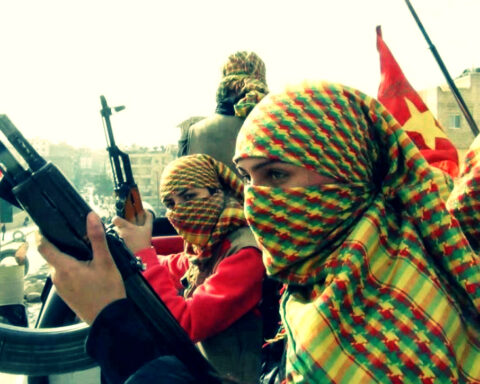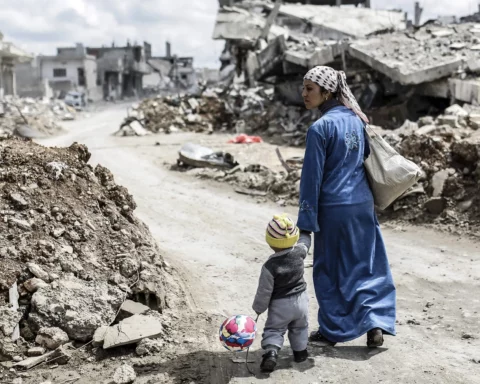Iran has erupted over the death of a young woman in police custody for “improperly” wearing the hijab. In the context of a deep economic and political crisis, Iranians are also questioning their deeply unpopular regime and its brutal oppression of women.
Last Tuesday evening, Mahsa (Zina) Amini, a 22-year-old ethnic Kurd from the western city of Saqez in the Kurdistan province, was detained outside a metro station in Tehran by Iran’s notorious morality police.
Mahsa Amini was travelling with her family from Iran’s western province of Kurdistan to the capital, Tehran, to visit relatives when she was reportedly arrested for failing to meet the country’s strict rules on women’s dress, ie, not wearing the hijab and her trousers “correctly” and was brutally beaten in a police van, according to witnesses.
The news comes weeks after Iran’s hardline president, Ebrahim Raisi, called for stricter enforcement of the country’s mandatory dress code, which has required all women to wear the hijab head-covering.
According to Hrana, an Iranian human rights organisation, Amini’s family were told during her arrest that she would be released after a “re-education session”. But Amini was in a coma her family said, adding that they were told by hospital staff that she was brain dead.
She was accused of improperly wearing her hijab in a country which strictly enforces the compulsory covering of women’s hair and bodies. According to witnesses, she was beaten while inside a police van that took her to a detention center. Amini died on Friday in the hospital after spending three days in a coma.
Police in Tehran immediately denied responsibility for her murder and said she suffered “sudden heart failure” while waiting with other women at the facility to be “educated.” Amini’s arrest and death rapidly set off protests across the country, initially starting outside the hospital where she died and spreading to other provinces. Throughout social media, she has already become a symbol for the struggle against the compulsory hijab and police across the world.
While Iran’s President Ebrahim Raisi called Amini’s family to express his condolences, he’s mostly dealt with the crisis — one of the biggest of his first year in office so far — by brutally repressing the Iranians who have taken to the streets. The repression has particularly targeted the Kurdish regions that have gone on general strike in protest against the killing of Mahsa. At least 10 major cities have been shut down since Monday despite intense police repression.
Hundreds of brave Kurdish women protesting the mandatory hijab took off their scarves during Amini’s funeral and waved it in the air while chanting slogans in Kurdish and Farsi: “Death to the dictator!”; “Killing for the scarf, how long will it be?”; and “Woman, Life, Freedom.” Security forces later shot some of the protesters and attacked many with tear gas, injuring at least 30.
Elsewhere in Iran, security forces have cut off internet access and attacked and arrested protestors, beating people indiscriminately in the streets and targeting activists in the women’s movement. Like in previous struggles, the student movement has been at the forefront of organizing mobilizations, with major protests breaking out in campuses across the country despite the presence of repressive forces and potentially severe consequences for students.
In a joint statement, fourteen student organizations from schools including Amirkabir University, Tarbiat Modares University, and Allameh Tabataba’i University called for a “dissolution of the Guidance Patrol and Morality Police as one of the most important institutions of repression post-revolution” in Iran.
The protests have not only led to a deeper questioning of the police, but also a deeper questioning of the regime among broader sectors of society. At protests, demonstrators are using anti-regime slogans such as “Death to Khamenei!” referring to regime supreme leader Ali Khamenei. Other slogans included “Death to the dictator!” and “No fear! We’re all together!” Importantly, some protesters are condemning the brutal authoritarian rule of both the U.S.-backed Shah’s regime, which lasted from 1941 until the 1979 revolution, and the current Islamic regime against the monarchist perspective of some Iranians who advocate for a return to Iran’s monarchy through the son of the late Shah.
The Iranian diaspora, which is estimated to include at least six million Iranians around the world, has also been active in organizing protests against Amini’s atrocious murders, particularly in Europe, Toronto, and New York.
Iran’s Deepening Fault Lines
Mahsa Amini’s shocking murder and resulting social unrest are creating a difficult political backdrop for Raisi who is set to speak at the UN general assembly in New York on Wednesday.
Beyond quelling the popular discontent, Raisi faces an erosion of legitimacy of Iran’s regime which has strong theocratic features. This political crisis is also marked by a widening of the rift between the two wings that have come to dominate Iranian politics: the “reformists” and the more conservative “hardliners.” Thus far, pro-reform figures like former President Mohammad Khatami have questioned the regime’s response to Amini’s death. Former lawmaker Ali Motahari also wrote that he feared that the incident could portray the Iranian government internationally as an entity like the Taliban in Afghanistan.
Other reformists have gone further to release statements against mandatory hijab and the morality police. Reformist lawmaker Parvaneh Salahshouri, the leader of the Women’s Faction in Parliament, wrote against the compulsory hijab in 2018 and, as recently as August 2, 21 prominent reformists had also denounced mandatory hijab laws.
Recent reports on the frail and ailing health of Iran’s supreme leader, Ayatollah Ali Khamenei, have also opened up questions about political uncertainty and even deeper factional divisions, as Khamenei’s death would open up a power struggle over his successor.
The deepening crisis of the Iranian regime cannot be seen outside of the dissolution of the Iranian nuclear deal, which had provided temporary relief from some sanctions — a strategic aim of both wings of the regime. The imposition of Trump’s “maximum pressure” sanctions, which Biden is continuing, have plunged the country into an unprecedented economic crisis, primarily affecting the workers and poorest sectors of Iranian society, who expressed their rage at the economic situation during two important waves of class struggle in 2018 and 2019.
Since then, the regime has responded to the unstable situation by expressing its more bonapartist features and relying heavily on its repressive apparatus to crackdown on any discontent. In addition to the increased repression, last year’s presidential elections underscored the undemocratic aspects of the Iranian “republic” in which the 12-person Guardian Council responsible for approving candidates for elections essentially blocked the nomination of anyone who can possibly challenge Raisi as a way to effectively secure the election of the hardliner.
These tendencies toward bonapartism are undoubtedly linked to the growing political influence of the Islamic Revolutionary Guard Corps (IRGC), a powerful security force and internal police which by some measures controls two thirds of Iran’s GDP and is increasingly competing with the clergy for power. Their historic role can be traced back to helping to consolidate the Islamic regime during the Iranian counterrevolution and the functioning of the IRGC expanded greatly in the political crisis set off by the aftermath of the 2009 elections which they played an important role in suppressing.
In recent months, the increased persecution of prominent political activists in Iran, especially women like Leila Hosseinzadeh and Sepideh Rashno, has put a spotlight on the rigid discipline of the reactionary regime which beyond the oppression of women (Iran is one of the world’s top executioners of women) and the brutal punishment of the queer community as the recent death sentences of queer activists, Zahra Seddiqi Hamedani and Elham Choubdar show, also extends to the denial of basic democratic rights like the recognition of independent trade unions.
Developing Tendencies toward Crisis and Class Struggle
Since the beginning of 2022, the social atmosphere in the country has also been marked by waves of protests and strikes, mostly targeting water shortages and the growing cost of living crisis exacerbated by the war in Ukraine. As Red Flag recently reported, the Iranian economy is facing a serious crisis:
The currency hit its lowest value ever in June and annual inflation is sitting at 41.5 percent and climbing, according to figures from the Statistical Center of Iran. The price of essential foodstuffs has increased by 90.2 percent, and household expenditures have tripled, while real wages continue to decline.
The effects of crippling maximum pressure sanctions, coupled with the seemingly comatose nuclear deal, has led the regime to impose austerity as a way to make workers pay for the crisis that is crushing them. Already, Raisi has introduced a slew measures like cuts to wheat subsidies and an elimination of pharmaceutical subsidies. As a result, there has been a thirteen-fold increase in the price of bread, and bread riots quickly emerged in the southern province of Khuzestan, which is home to a large Arab minority and a frequent flashpoint of struggle due to environmental problems in the region and the presence of the militant sugarcane workers of the Haft Tappeh union.
Within the workers’ movement, teachers have also led struggles related to the cost-of-living crisis and have spearheaded a series of nationwide strikes, rallies and occupations, including huge demonstrations across the country on May Day this past year as part of the Coordinating Council of Teachers’ Trade Unions. On a political scale, new Marxist organizations (largely operating underground) like the “Labour Organised Action Committee” (LOAC) are emerging among the student and workers’ movements as revolutionary socialist ideas re-emerge among the Iranian vanguard which has been involved in the recent waves of struggles from the mass uprising in 2019 to the oil workers’ strike in 2021.
From Fury to Freedom
The social explosions emerging in Iran have the potential to build threads of continuity with the historic struggle of the Iranian masses against their oppressive regimes and the threat of imperialism. In order for the mobilizations that are emerging against women’s oppression to advance in a way that responds to the interests of the oppressed and exploited in Iran, it’s important to tie the struggle against Iran’s particularly undemocratic and patriarchal regime with a struggle against the capitalist system that sustains the bourgeois mullahs.
In that sense, the convergence of the burgeoning women’s movement with Iran’s combative working class that has emerged as an important actor in recent struggles can play an important role in pushing these struggles forward. Let us not forget that the Iranian revolution was set off by the Shah’s violent suppression of protests and authoritarian rule. It was the oil workers’ strike in response to this repression that set off a general strike that brought the Shah’s regime to its knees. The oil workers in Iran today have the potential to wield their strategic power in a similar way.
And the Iranian revolution was not only a revolution against the Shah’s regime but a revolution against the imperialist forces that benefited from his rule. These lessons are important today, as imperialist countries like the U.S. and France denounce the murder of Mahsa Amini as a way to conceal their own interests. These are the so-called “democratic” countries whose police also brutally murder women, whose regimes deny the right to abortion, and impose racist hijab bans limiting a woman’s autonomy from another angle. These are the countries that impose maximum pressure sanctions that inflict suffering on Iranian workers everyday.
Against the Iranian ruling class and foriegn powers, the involvement of the left can be decisive in fighting back independently against these oppressive attacks. After all, it was Marxist women who organized the first massive protests against compulsory veiling during International Women’s Day in 1979.
The international Left and feminist movements around the world should also take up the banner of the Iranian women, youth, and workers in struggle, in the spirit of the George Floyd protests which spread globally. The problems we face as a class go beyond our borders and can only be resolved internationally.
_________
written by
Maryam Alaniz
Maryam Alaniz is a socialist journalist, activist, and PhD student living in NYC. She is an editor for the international section of Left Voice. Follow her on Twitter: @MaryamAlaniz
